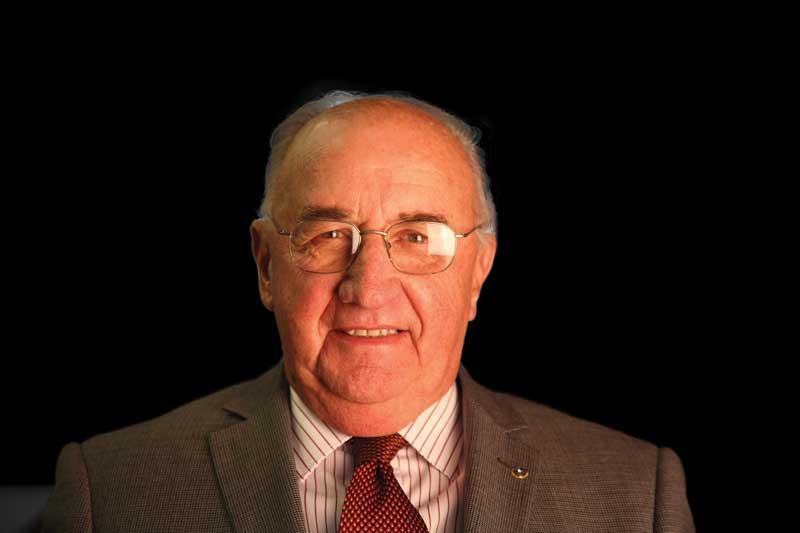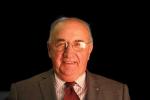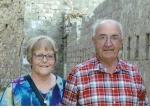Tony Barbarich

People who know the Auckland octogenarian and New Zealand Metal Roofing Manufacturers life member Tony Barbarich, Director – Business Development, MetalCraft Roofing, Auckland, tend to use the same descriptions when talking about him. He never loses his cool, talks sense and people listen to him.
TONY Barbarich has been working for 65 years and the 34-year executive member of the New Zealand Metal Roofing Manufacturers is not quitting yet. Even more remarkably, if he were to start his working life again, he’d do it all again.
His father was a Northland gumdigger when Tony was born in Mangawhai in 1936. He was 10 when his parents opened a fish shop in Hobson Street, Auckland and he attended Marist School Vermont Street and Sacred Heart College.
In February, 1952, he started with Winstone Group as an apprentice motor mechanic. He worked his way up, and up, and up until he was managing a huge fleet of 250 vehicles. Just over 30 years later, his last role there was Corporate Distribution Manager which included all transport, distribution and vehicle purchasing operations..
In 1983, he moved into roofing when he was appointed general manager of Dimond Industries, Winstone’s roll-forming subsidiary. He was quickly on the executive of the Metal Roofing Manufacturers, a post he still holds.
The shift came because Winstone believed in moving appropriate senior managers about the company to lead and gain additional experience in subsidiaries. Fletcher Challenge acquired Winstone Group in 1988. It had its own roll-forming business, Brownbuilt, which he integrated with Dimond. In 1989 he became general manager of the combined organisation, known eventually as Dimond Industries.
He was appointed President of Fletcher Challenge Steel International in 1994, and set up and ran the export steel business, a job which required a great deal of travel, particularly in Asia.
Then in 1996, he was appointed General Manager of CSP Pacific, the civil engineering steel products and galvanizing operations of Fletcher Challenge.
In 1998, he retired from the company, aged 62.
“I was really going to retire and maybe take on some consulting work on a casual basis,” he said.
But he was tapped on the shoulder by United Industries, a group of companies, one of them being MetalCraft Roofing where his role was Director-Business Development. Once again, he was back in roofing, although not full-time. “It’s a three-days-a-week job. I’ve been here ever since.”
When he started, there were four branches in Auckland, Hamilton, Palmerston North and Christchurch. Today he assists the Group managing director, John Williams, with running the national MetalCraft operation over its 12 branches from Whangarei to Cromwell.
“We grew the business and then we added branches,” he said. Its work is substantially in residential but it undertakes commercial work where required or where a specialist product is needed.
The challenges were no different than those other roofing companies faced. “We’ve been through the era with a big emphasis on occupational safety and health,” he said. “That was quite a big item for everyone in the roofing industry to get their heads around, to implement all of the changes that were required to comply with all the new rules.”
The company had to train all its people how to work at heights. It also had to make sure they were trained in the use of safety and related equipment.
“In the factories, we’ve had to go through the process of putting guarding on all of the machines. That’s all evolved over the past five years.”
Introducing new products always brought issues to resolve. “We’ve introduced a lot of new profiles into the market. They individually have their own challenges when you introduce them. But they’ve all bedded down now.”
The arrival of less expensive imported coil which meant increased competition had been another challenge. “We buy generally New Zealand-made coil.”
One of the bigger and more interesting jobs was for Fonterra at its plant near Hawera in 2014, which required an on-site roll-forming machine. Lengths of up to 63m were manufactured on site and lifted into position using a specially manufactured beam. In all, the job had 33,000 sq m of roofing and cladding. “But we have a number of interesting, regular jobs particularly with our Espan® profile which is tailored towards architectural design. A number of our jobs have been featured in Scope.”
Tony has had considerable influence in the MRM as a member of the executive since 1983 and president on two occasions, in 1987-1988 and 1997-98. He believes MRM has done a lot of good work, probably more so in the last decade.
One important piece of work where he was heavily involved was in writing the Metal Roofing Code of Practice. The work was started by the late Stuart Thomson and Brian Cosgrove, of Timaru, and when the latter retired from the executive, Tony took over.
“Tony was a great watchdog in that role,” said Brian, who had followed his father into the business through Dan Cosgrove Ltd, a company he operated until 2014. The implementation of the COP required considerable liaison with other industry groups so that standards were consistent. Once written, it meant the metal roofing industry had demonstrable standards of workmanship.
Brian first met Tony in 1983. “When he spoke, people would listen. He always had a lot of common sense and could sum up a situation well.”
He was also methodical and keen to see the association followed the industry guidelines.
“That was one of the most significant undertakings we’ve made as an association,” Tony said of the Code of Practice. “ It’s being updated at the moment but it’s really ended up being the Bible of the roofing industry. It was probably a four or five year project from start to finish, done on a part-time basis, as those on the executive are.”
Stuart Hayman, the MRM’s consultant on technical issues since 2009, is another who has worked closely with Tony for a long time on technical issues and external relations. A long-standing member of the Technical Committee, Stuart’s early memory of Tony was that seemed to be on every committee existing. Resolving technical issues has become a vital part of the MRM’s work and even though Tony was deeply involved in the political side of the business, Stuart had never seen him lose his cool.
“Tony is a very well respected and senior member of the industry,” he said.
A huge challenge for the association arose in 1985 when coloured steel roofs came on to the market. They were immediately popular but fading issues arose. MRM, under President Darrell Back, of New Plymouth, and fully supported by Tony, had become a more pro-active organisation rather than one loosely representing the industry. Darrell recalled: “The first big challenge we had was a massive paint failure on pre-painted roofs. Tony was very much to the fore in that and we actually managed to get the paint companies internationally to take responsibility for the paint fade, instead of the rollformer companies.”
The astute businessman had other skills that served the association well, such as good contacts in the likes of MBIE. He had spent six years on the Building Research Association of New Zealand (BRANZ) board.
Tony and Gary MacNamara instigated Scope magazine in 2002 to provide a contact point with the industry and to showcase what members were capable of. From 20 pages, it grew to 42. Gary, Auckland manager of Edwards and Hardy Roofing, who enjoyed a long association with Tony, worked with him on that project.
At the time, MRM was debating what value it delivered to members. There was core value around the code of practice and compliance but how could it promote specification of steel over other products? “It was from that background that Scope magazine originated,” Gary said.
It became a magazine to celebrate the use of steel and, through articles and photographs which showed what members were doing, encouraging customers, clients and architects to be part of that celebration.
Tony was always supportive of anything that added value to members, Gary said. “He wore an MRM hat while he was engaged on MRM business and then wore a MetalCraft hat when he was engaged on his general duties.” He admired Tony’s ability to handle his two roles – “A lot of people struggle with that.” His focus was to add value to members via MRM, a desire that flowed on to other projects.
Gary found him a grounded leader, sensible, straight-talking and not given to playing games.
He would bring his wife, Maureen, to conferences, and family was clearly a big part of his life. So what’s next for Tony Barbarich? When will he retire for the second time? “I will one day,” he said. “I’m not sure when. I enjoy the work.”
Where does he see roofing going?
“I think we will always see metal roofing used in both the commercial and residential market. I don’t see anything taking it over. I see that as a long-term situation,” he said.
When he started his working life, he never envisaged ending up in the roofing business.
“I thought I’d probably be staying somewhere in the transport industry. But I’ve ended up probably doing 50 percent of my working life in transport and 50 percent in roofing.” If he had his time again, would he take the same path? “I probably would,” he said, chuckling. “I obviously enjoyed it because I continue to do it.”
In his leisure time, he follows his interest in classic cars, particularly British MGs. He goes on regular runs in his MG CGT and 2004 MG TF. He’s been a member of the Rotary Club of Otahuhu since 1990, was president in 2000-01 and is a Paul Harris Fellow. He and Maureen have one daughter, four grandchildren and one step grandson, aged from 29 to 16. “Obviously, we have an interest in what our grandkids are doing.”
That has already taken them afar, watching grand-daughter Ainsley Thorpe, 19, and grandson Trent Thorpe, 21, representing New Zealand at the World Triathlete Championships in Holland.
“We keep an eye on them.”



